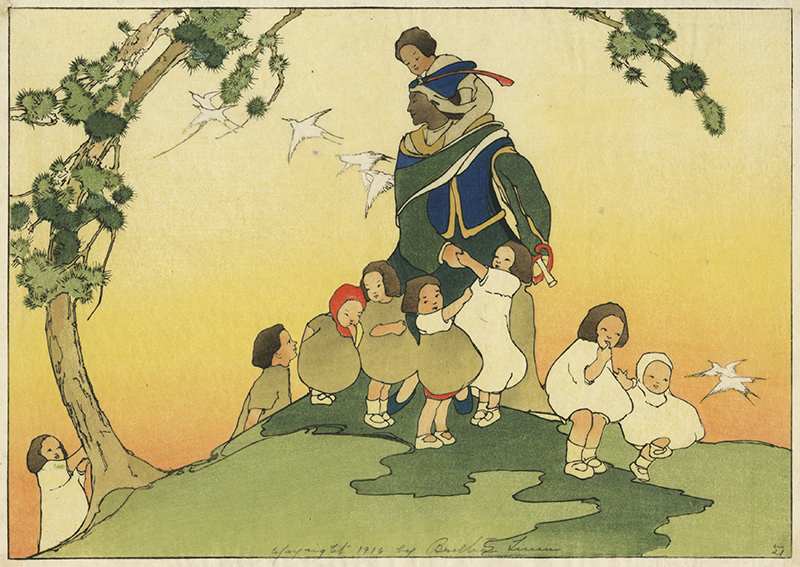
19th, 20th & 21st Century Fine Prints
707-546-7352 · fax 707-546-7924 · web: www.annexgalleries.com · email: artannex@aol.com
The Piper a.k.a. Pied Piper by Bertha Lum

The Piper a.k.a. Pied Piper
Bertha Lum
The Piper a.k.a. Pied Piper
Bertha Lum
1869 - 1954 (biography)According to the website dedicated to her work, Bertha Lum used anywhere from three to thirty blocks to achieve the glowing tonality she was known for. "Pied Piper" required 12 blocks to complete, and captures a moment in the famous medieval legend when the Piper, having been left unpaid for his rat-removal services by the greedy townspeople, begins to lure their children away with his pan-pipe tune. Lum gives the scene a bucolic feel, backing the Piper and the dancing forms of the children with a glowing, sun-warmed sky..
The roots of the Pied Piper story, in which the town of Hamelin lost 130 children under mysterious cirumstances, dates 1284. Accounts vary as to how it happened, but theories of an illness, a natural disaster such as a landslide, or of the children being sold to a recruiter from the Baltic region of Eestern Europe to populate the area, nevertheless illustrate an event of great sorrow. The Piper is considered a symbol of Death, and the village's account of their children following a mysterious, pipe-playing stranger out of the village a metaphor for the parents' collective grief. A stained glass window that once decorated the Church of Hamelin in Germany (destryed in 1660) commemorated the tragic incident on its 100th anniversary, and is thought to have been the inspiration for the folkloric version of the story. This mystery fascinated authors for centuries, and was made popular by the Brothers Grimm; since, it has been an equal source of inpiration for artists and illustrators..
In 1907 Lum returned to Japan for fourteen weeks (she had honeymooned there in 1903) where she met and studied with the master woodblock cutter Bonkotsu Igami who taught her the Japanese blockprinting methods..
Under his direction Lum hired professional craftsmen to work in her home and together they created compositions that drew heavily from Japanese aesthetics. Lum learned the techniques of using modulated color on a single block to give depth to the flat surfaces and to carve delicate lines to create the patterns of the kimonos and hair, while leaving the color of the paper to create the foreground..
Bertha Boynton Bull, was born in Tipton, Iowa and spent her youth in Iowa and Duluth, Minnesota. In 1895, she attended the Art Institute of Chicago for one year, focusing on design. A few years later studied stained glass with Anne Weston and illustration at the School of Illustration with Frank Holme. In the fall of 1901 to March 1902, Lum studied figured drawing at the Art Institute of Chicago. In 1903, Bertha married Burt F. Lum, a corporate lawyer, and their honeymoon voyage to Japan in 1903 was the precursor to Bertha’s exploration of and fascination with the Orient. Returning to Japan in 1907 for fourteen weeks, she gained an introduction to Bonkotsu Igami, a master block cutter in Tokyo, who disclosed to her the techniques of carving and arranged for her education in block printing..
Though married, Lum was fiercely independent and traveled for extended periods of time. Accompanied by her two young children, her 1911 sojourn in Japan lasted six months. By this time she had a thorough understanding of color woodcut and opted for the traditional division of labor. Lum moved easily within Japanese society and hers were the only foreign woodcuts in the Tenth Annual Art Exhibition in Tokyo in 1912. She was awarded the silver medal at the 1915 Panama-Pacific International Exposition and and her work was included in the 1919 Exhibition of Etchings and Block Prints at the Art Institute of Chicago..
Lum was in California at the end of 1916 and moved to San Francisco in the fall of 1917, but the following years were interrupted with travel. Her most extensive stay in California was between 1924 and 1927. The 1923 earthquake in Tokyo destroyed most of her blocks and many woodcuts. Lum spent the late 1920s and the 1930s living in Peking, returning to California in 1939. She spent a great deal of time in China between the years 1948 and 1953. Bertha Lum left China to be with her daughter Catherine who lived in Genoa, Italy and she died at the age of eighty-four in February, 1954.


